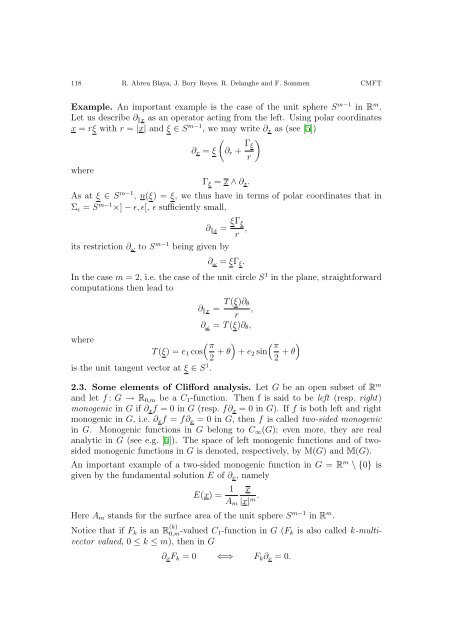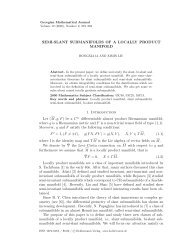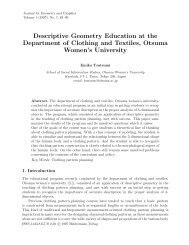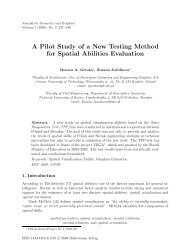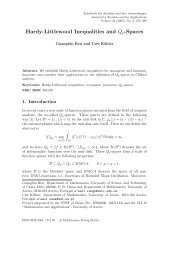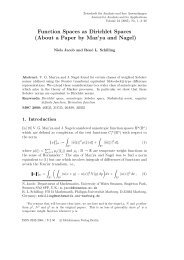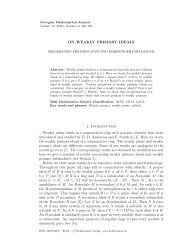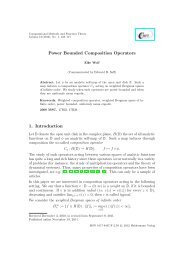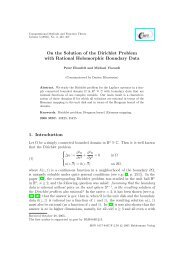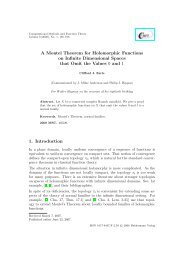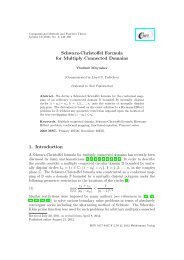Cauchy Integral Decomposition of Multi-Vector Valued Functions on ...
Cauchy Integral Decomposition of Multi-Vector Valued Functions on ...
Cauchy Integral Decomposition of Multi-Vector Valued Functions on ...
Create successful ePaper yourself
Turn your PDF publications into a flip-book with our unique Google optimized e-Paper software.
118 R. Abreu Blaya, J. Bory Reyes, R. Delanghe and F. Sommen CMFT<br />
Example. An important example is the case <str<strong>on</strong>g>of</str<strong>on</strong>g> the unit sphere S m−1 in R m .<br />
Let us describe ∂ ‖x as an operator acting from the left. Using polar coordinates<br />
x = rξ with r = |x| and ξ ∈ S m−1 , we may write ∂ x as (see [5])<br />
(<br />
∂ x = ξ ∂ r + Γ )<br />
ξ<br />
r<br />
where<br />
Γ ξ = x ∧ ∂ x .<br />
As at ξ ∈ S m−1 , n(ξ) = ξ, we thus have in terms <str<strong>on</strong>g>of</str<strong>on</strong>g> polar coordinates that in<br />
Σ ɛ = S m−1 ×] − ɛ, ɛ[, ɛ sufficiently small,<br />
∂ ‖x = ξΓ ξ<br />
r ,<br />
its restricti<strong>on</strong> ∂ ω to S m−1 being given by<br />
∂ ω = ξΓ ξ .<br />
In the case m = 2, i.e. the case <str<strong>on</strong>g>of</str<strong>on</strong>g> the unit circle S 1 in the plane, straightforward<br />
computati<strong>on</strong>s then lead to<br />
where<br />
is the unit tangent vector at ξ ∈ S 1 .<br />
∂ ‖x = T (ξ)∂ θ<br />
,<br />
r<br />
∂ ω = T (ξ)∂ θ ,<br />
( π<br />
) ( π<br />
)<br />
T (ξ) = e 1 cos<br />
2 + θ + e 2 sin<br />
2 + θ<br />
2.3. Some elements <str<strong>on</strong>g>of</str<strong>on</strong>g> Clifford analysis. Let G be an open subset <str<strong>on</strong>g>of</str<strong>on</strong>g> R m<br />
and let f : G → R 0,m be a C 1 -functi<strong>on</strong>. Then f is said to be left (resp. right)<br />
m<strong>on</strong>ogenic in G if ∂ x f = 0 in G (resp. f∂ x = 0 in G). If f is both left and right<br />
m<strong>on</strong>ogenic in G, i.e. ∂ x f = f∂ x = 0 in G, then f is called two-sided m<strong>on</strong>ogenic<br />
in G. M<strong>on</strong>ogenic functi<strong>on</strong>s in G bel<strong>on</strong>g to C ∞ (G); even more, they are real<br />
analytic in G (see e.g. [5]). The space <str<strong>on</strong>g>of</str<strong>on</strong>g> left m<strong>on</strong>ogenic functi<strong>on</strong>s and <str<strong>on</strong>g>of</str<strong>on</strong>g> twosided<br />
m<strong>on</strong>ogenic functi<strong>on</strong>s in G is denoted, respectively, by M(G) and M(G).<br />
An important example <str<strong>on</strong>g>of</str<strong>on</strong>g> a two-sided m<strong>on</strong>ogenic functi<strong>on</strong> in G = R m \ {0} is<br />
given by the fundamental soluti<strong>on</strong> E <str<strong>on</strong>g>of</str<strong>on</strong>g> ∂ x , namely<br />
E(x) = 1 x<br />
A m |x| . m<br />
Here A m stands for the surface area <str<strong>on</strong>g>of</str<strong>on</strong>g> the unit sphere S m−1 in R m .<br />
Notice that if F k is an R (k)<br />
0,m-valued C 1 -functi<strong>on</strong> in G (F k is also called k-multivector<br />
valued, 0 ≤ k ≤ m), then in G<br />
∂ x F k = 0 ⇐⇒ F k ∂ x = 0.


